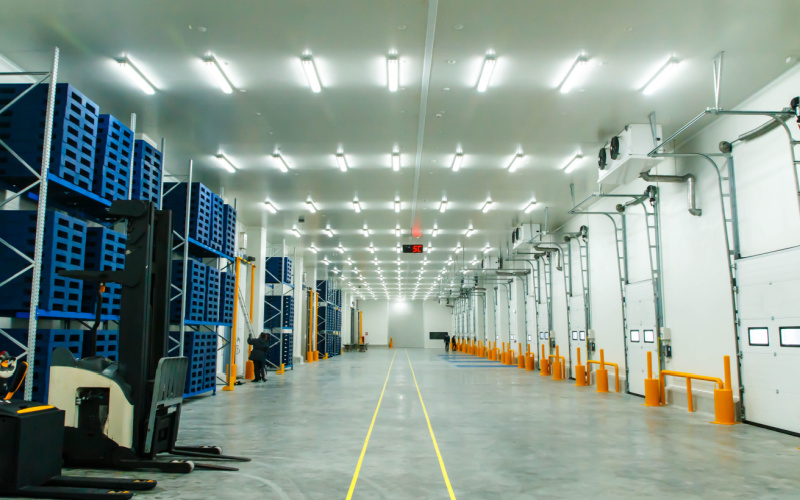Master the Challenge of Cold Chain with Blue Yonder (Part 2)
My previous blog article focused on the size of the cold-chain market — $1 trillion by 2030 — and the huge opportunity it presents for the world’s logistics service providers (LSPs). How can the typical LSP capitalize on this large and growing revenue stream? And how can Blue Yonder help?
That was the topic of a conversation I had recently with Ann Marie Jonkman, Senior Director of Industry Strategy for LSP/Cold Chain at Blue Yonder. Ann Marie provided an overview of this topic during a LinkedIn Live event I hosted back in December, then she sat down with me this month for a longer discussion.
In the first installment of my two-part blog series, Ann Marie discussed the top priorities for LSPs who want to master the complexity of cold-chain logistics. Those priorities include supply chain digitalization, regulatory compliance, increased sustainability, workforce training, technology adoption, and closer partnerships across the end-to-end logistics network.
As a leading software supplier to the global logistics community, Blue Yonder has a special interest in the first priority — supply chain digitalization. But that’s a broad topic. So this second blog post answers the trillion-dollar question: How exactly can supply chain solutions, including software from Blue Yonder, help LSPs master the cold-chain logistics challenge?
Five Key Software Capabilities for Cold Chain
LSPs should look for five key capabilities when choosing a software provider to help them manage the harsh realities of storing, distributing and transporting temperature-controlled products. These five capabilities are important for any supply chain, but absolutely imperative when it comes to cold chain.
1. Real-time, end-to-end visibility and traceability.
“Accuracy, speed and awareness are critical when it comes to maintaining product temperature and quality as cold-chain products move through the logistics network,” said Ann Marie. LSPs should look for software solutions that span all aspects of logistics and integrate well across forecasting, planning, transportation, warehouse, labor, warehouse execution, yard, and order domains. They should also connect seamlessly with external partners to enable end-to-end visibility and tracking for raw materials. Dashboards and visualization tools help LSPs achieve a clear, concise view of the entire cold-chain process, enabling proactive decision-making. Exception alerts and notifications warn users about disruptions, delays, and temperature deviations. In cold-chain applications, it’s especially important that software solutions integrate with sensors and tracking devices to allow real-time monitoring of temperature, humidity, location, and compliance.
2. Data analytics and insights.
“Manual analysis and spreadsheets just aren’t capable of managing all the complexities of modern cold-chain logistics,” Ann Marie pointed out. “LSPs need the power of artificial intelligence (AI), machine learning (ML), predictive analytics, and advanced software functionality.” These leading-edge capabilities help LSPs analyze trends, predict disruptions, improve efficiency, optimize routes, minimize and identify potential risks, and gain insights into performance across the cold chain.
3. End-to-end integration and automation.
Cold-chain logistics can’t be managed as a series of disparate, disconnected tasks. Instead, LSPs should leverage a platform-based software solution that integrates the demand forecasting, planning , warehouse management system (WMS), transportation management system (TMS), and order management system (OMS) for seamless data flow improved efficiency LSPs need to ensure seamless data flow and process orchestration across all aspects of the supply chain. “Automation is important for increasing productivity, offsetting labor costs, and improving profitability,” noted Ann Marie. LSPs should choose software that automates routine tasks such as forecasting, order processing, route planning, and temperature monitoring and adjustment.
4. Security and compliance.
“Any software used to manage perishable products must feature robust security protocols that protect sensitive data and comply with industry regulations,” Ann Marie emphasized. The chosen solution should support LSPs’ need for audit trails and traceability, enabling the detailed tracking of all products and actions throughout the cold chain process. Software should also include compliance reporting tools that help LSPs demonstrate their observance of all relevant industry regulations and standards.
5. User-friendliness and accessibility.
Finally, Ann Marie stressed the importance of usability. Logistics software, no matter how advanced, should be easy and intuitive for all users to learn and deploy, with a user-friendly, accessible interface. “Since cold chains are global in nature, software should offer multi-language support, cater to a global audience and facilitate international trade,” she added. “Mobile access is also essential in enabling users to monitor and manage cold-chain operations from anywhere, at any time.”
Prepare for Cold-Chain Leadership by Adding These Capabilities
Beyond these five key capabilities, we noted that logistics software should be scalable, extensible and adaptable — to grow with LSPs as their cold-chain operations expand. To accommodate the needs of different LSPs, the software should offer flexible deployment options, including on-premises, cloud-based and hybrid approaches.
“Since cold-chain logistics is a capital-intensive business, LSPs should also choose software that is cost-effective, with competitive pricing and subscription models,” she said. “Look for a software provider with deep experience and hundreds of implementations, so you can benefit from a rapid launch and an early return on investment.”
Start Driving Cold-Chain Success Today With Blue Yonder
The criteria outlined sound impossible to meet — but Blue Yonder’s solutions in transportation management, warehouse management, warehouse execution system, and order management are purpose-built to deliver all these capabilities, and more. Unified on Luminate® Cognitive Platform, Blue Yonder’s powerful software seamlessly integrates every aspect of cold-chain logistics. Our industry-leading solutions have driven incredible results for the world’s top logistics teams, including many cold-chain leaders. Reach out to Blue Yonder today to get started on the road to cold-chain success.

